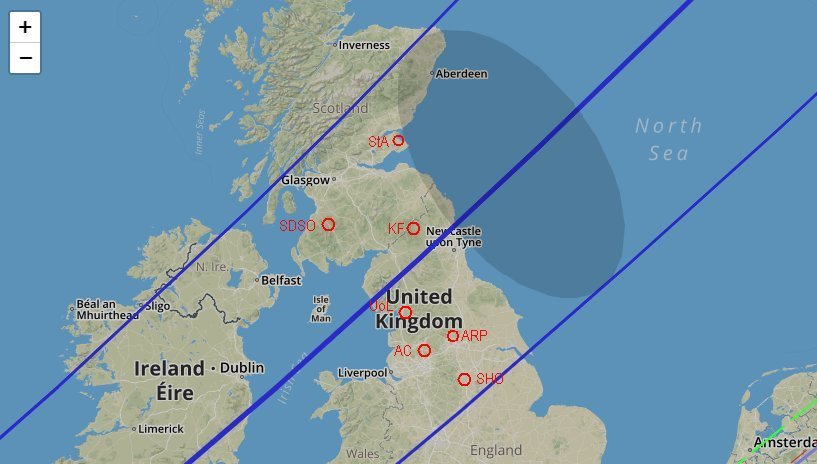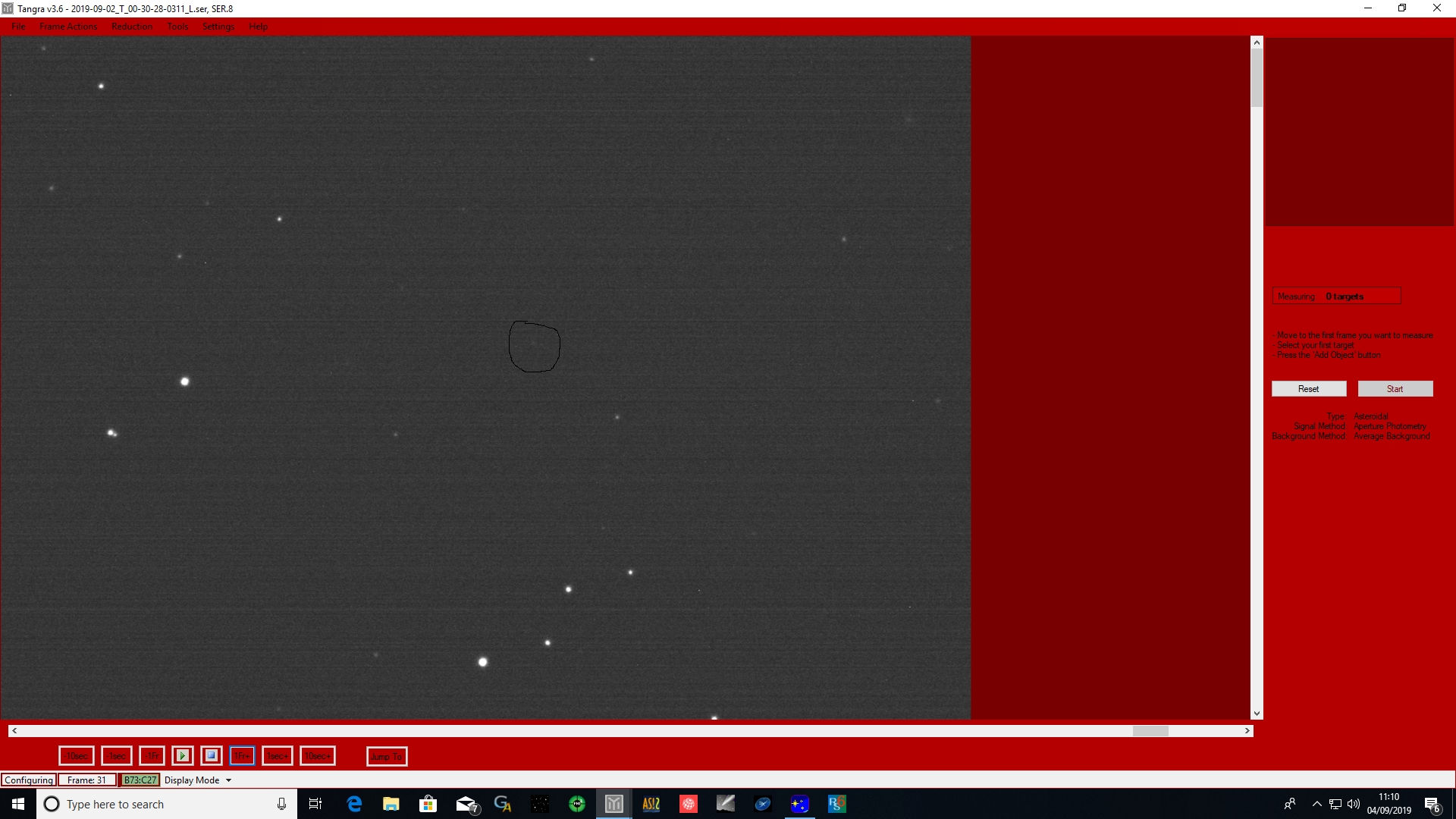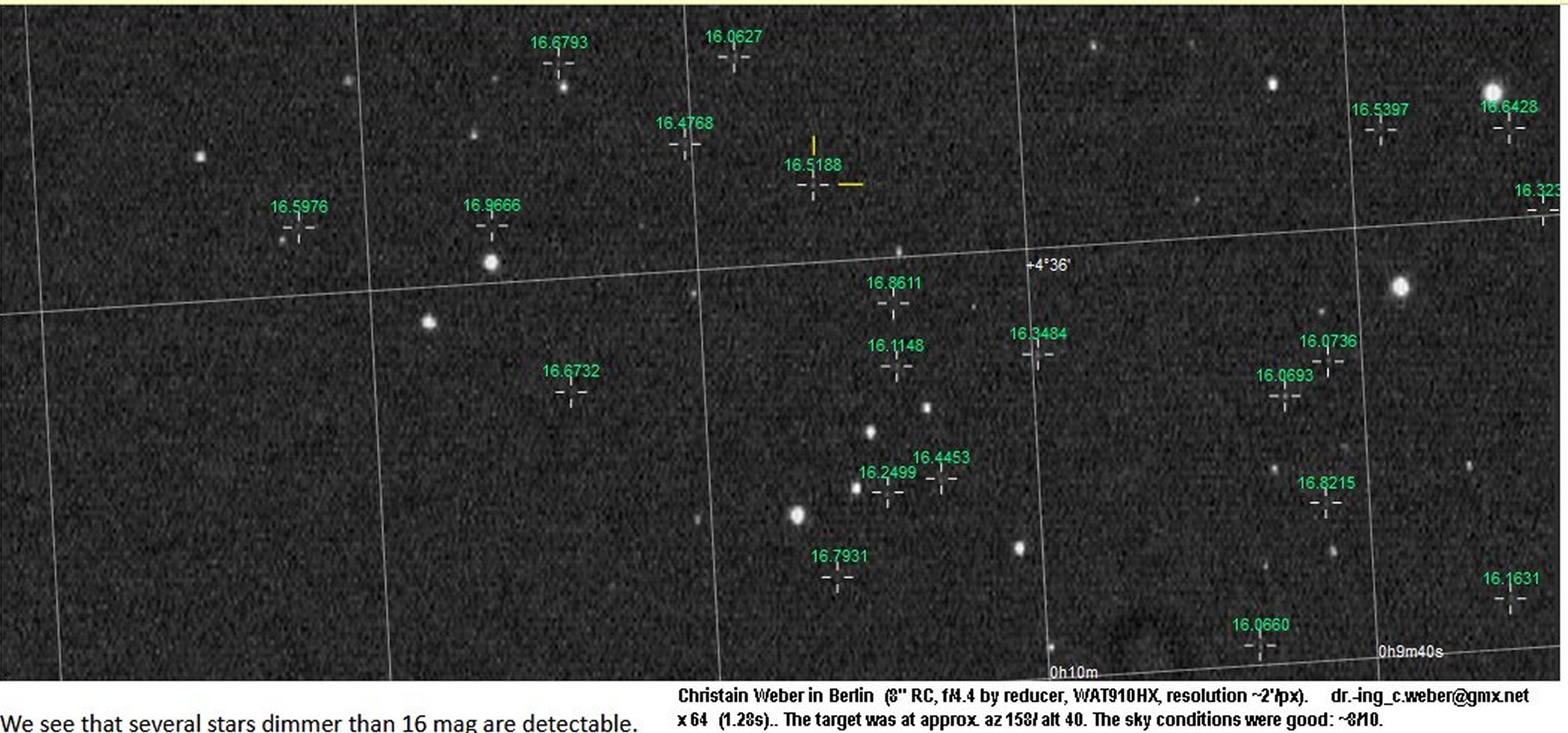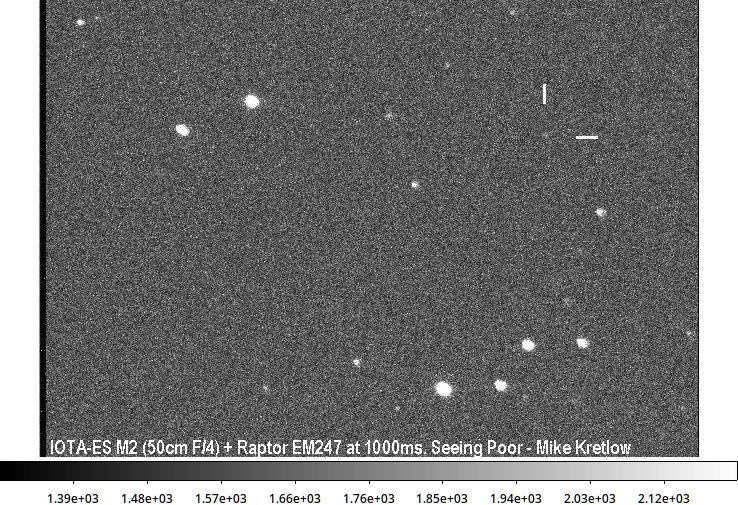(2060)Chiron
Lucky-Star campaign: 2019-Sep-08
Updated: 2019 SEPT 04
and 2019 SEPT 11 NEW Test Images AddedIntroduction
Prof. Bruno Sicardy et.al. (ERC Lucky Star project, l'Observatoire de Paris) and IOTA-ES (pro-am collaboration) request amateur observers in the UK to monitor this prediction involving the total occultation of 16.4 magnitude star in Pisces: UCAC4 474+000226 at altitude/azimuth of 35/141 on September 8th centered at 2304 30s +/- 13 sec UT. The Moon is setting.
Suggested recording time is 2302 to 2307 UT. The maximum event (D-R) duration is 10 sec. A 40 to 70 cm appeture has been suggested and 1 to 3 sec cadence (or shorter)
http://lesia.obspm.fr/lucky-star/occ.php?p=3885
UPDATED PATH 2019-10-01: http://lesia.obspm.fr/lucky-star/occ.php?p=18685
Chiron is one of the Centaurs, otherwise classified as 95P/Chiron, the most distant minor planet at the time of discovery in 1977 and believed to be a comet with an Aphelion of 18.9 AU, and orbital period of 50 years.
The next star occultation is over the British Isles on 2019 Sept 08 at 2304 UT, when the shadow is predicted to cross the UK. The uncertainty indicates that observers anywhere in the UK should attempt to observe. It will be a challenging observation so planning and test runs are suggested. It should be interesting! The probability of recording an occultation (due to prediction errors) is 39%. Please report all recordings.
Predicted shadow and centre line. Some observatories are marked. [ See updated path above ]

Key: Invited observatories ( List under development )
Planned observations ( test runs and other factors allowing...)
REPORTS- the UK was under a cloak of cloud.
Sherwood Observatory, (Mansfield
and Sutton AS) ...........Cloudy, and would like
to continue with more events.
West Park Observatory, (Leeds),...........................................No
Observation
The Amateur Astronomy Centre, ( AAC,Todmorden)..........Set
up, but cloudy
University of St Andrews..........................................................No
stars (Clouds)
University of Central Lancashire (uclan).................................No
Observation
S Kidd (Stevenage)..................................................................No
Obsevation
Isle of Man AS...........................................................................No
Observation, Cloud
Clanfield 40cm Newt - D Briggs.............................................Cloud
and technical problem
Observing Aims
The lucky-star project need many more chords to improve the shape profile of this minor planet. A time accuracy (exposure) of 1-2 sec should provide new data. ( 1 to 3 sec cadence possible). Of more interest is the search and detection of rings or possible satellites. This will require a time resolution (exposure) of the order of 200ms. Ring detection may require a 50 to 80cm class instruments and dark skies.
What the amateur can contribute with 30 to 40cm, are the chord information (duration of occultation) from widely spaced positions across the path. Video cameras such as the integrating WAT-910HX would be ideal, but any mono camera could be used. Larger CCD/CMOS cameras should be operated in binning mode (e.g. 2x2 or 3x3) to obtain a plate scale near 1 arcsec/pixel (typical). Some experimentation prior to the event will be needed. Please check the PC clock time is correct to within 50ms of UT prior to recording, and afterwards.
Suggested
systems:
30-40cm SCT, F 3.3 reducer,
50 to 70cm Newonian. RC etc.
Large Dob and video.
Observing / recording
protocol
Obtain some test sequences on the star field days/week before under
good conditions to check detection, and become familiar with the setup.
We assume the observatory will have some light pollution, and SQM 20
may be typical (20 mag/arcsc2).
Check the PC clock is synchronize to UT via NTP, or some other means. Make a note of any offset before and after observation.
Focus the camera
Goto the star.
Use binning and/or
sub-frame to optimise detection and cadence.
Check there is at least one other brighter star in the field of view
to monitor seeing condiions.
Prepare to record from 2302 to 2307 UT at 1 to 3sec cadence, or adjust for best detection.
Optimisation
1) Use a focal length that matches the detector pixel size. We should
aim for a star image that fills one pixel. Due to changes in seeing
stability the star image can fluctuate between 1 and 3 arcseconds in
size. The image should be oversampled a little bit, but not a lot. Using
my 30cm F/4, the plate scale with a video camera of 8.5x8.5um pixels
is 1.5 arc sec.
A 40cm SCT with F3.3 reducer and same video camera gives 1.3 arcsec/pixel
A 40cm F/8 RC and ATIK 314L+
produces 0.4 arcsec/pixel. This is a bit too small, and CCD 2x2 binning
would improve sensitivity and lower the image size Kb and improve cadence.
https://www.atik-cameras.com/news/binnning-the-differences-between-cmos-and-ccd/
2) Focus. A basic requirement and so important. Get good focus at the centre of the field using software or a mask, or use the diffraction spikes of a bright star.
3) Reduce light pollution.
Not easy. Local lighting can be nuisance, even inside the observatory.
4)
Unsure of this, but a mono USB2/3 planetary camera has greater bit depth
(10 - 12 bit) compared to analogue video (8 bit). This should give better
definition when recording faint objects.
5) Exposure/Cadence 1 to 3 sec.
FINDER CHARTS:
Coordinates
for
UCAC4 474-000226
00h 10m 13", +04d 37' 05" (J2000)
Star magnitude 16.1 to 16.5 depending on spectral type.
7 degree field:
1
degree field
0.3 degree field:
ALADIN Field. A cross marks the star.
Peter Tickner (Reading, UK). 35cm Meade SCT at F3.3, ASI174 uncooled, exposure 1.5 seconds, - via email
Dr-ing Christian Weber (Berlin) 20cm RC at F4.4, WAT-910HX, 1.28 seconds, - via the PLANOCCULT mailing list
Mike Kretlow (Germany) 50cm F/4 (IOTA-ES "M2" ), Raptor EM247, 1.0 seconds in poor seeing. - via email
Tim Haymes (Maidenhead, England), 20cm F/4 SN8, WAT-910HX at 5 sec exposure (x255), 30dB gain Haze? - via himself
Thierry Midavaine, et al, 60cm J-MS telescope F3, Buthiers. QHY174-GPS in 8-BIT mode, 1.0 seconds - via email
More information:
About occultations and this page:
This is a personal web page to support occultation observers. There
is a Yahoo! group: UKoccultations which observers are welcome to join.
An observation sent to the writer is checked and forwarded to the BAA
which will perform a preliminary analysis prior to submission to IOTA-ES
and for PRO-AM collaborations, to the designated data collector.
Acknowledgements:
ERC Lucky-Star
SkyMap pro 11 was used to present the path on the sky and the star fields.
Observers that have posted test images on discusion groups reproduced
on this page


